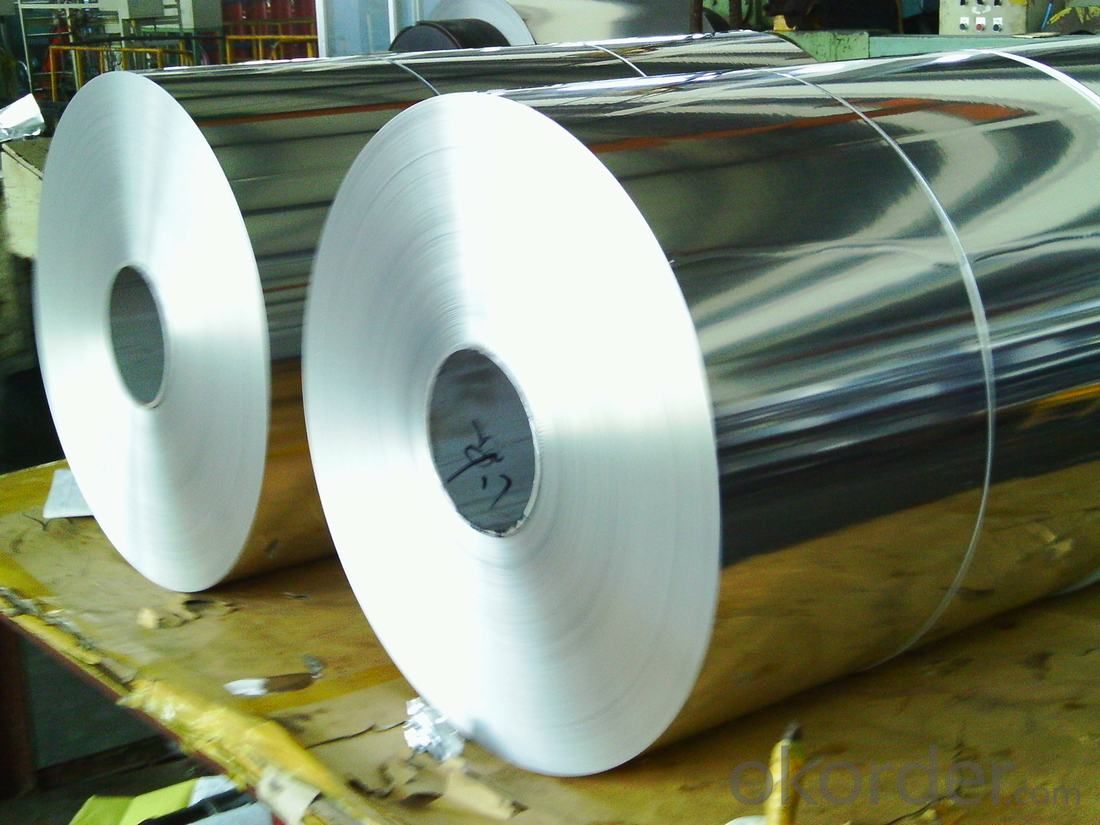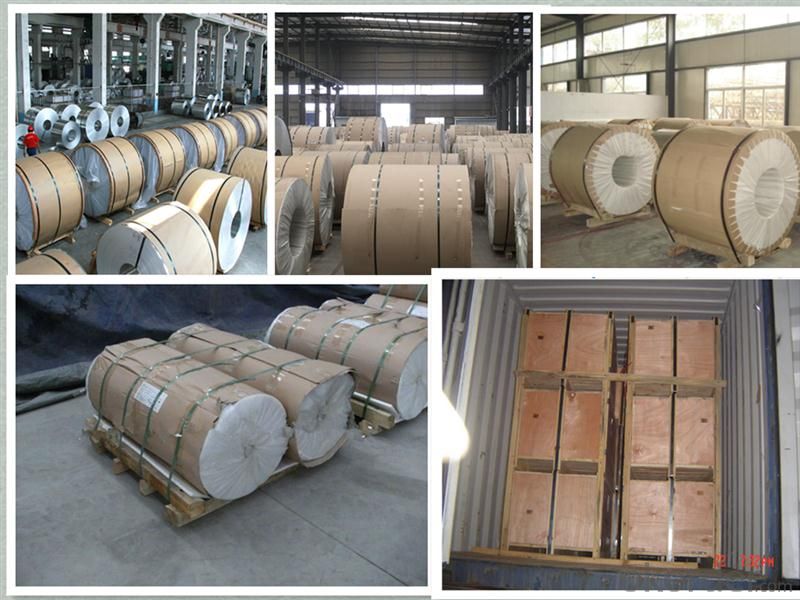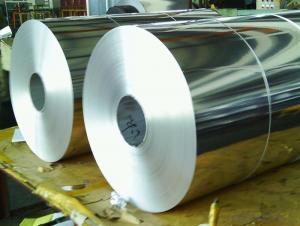CC Grade 1100/1050/1020/1060 Aluminum Coils with Bright Surface
- Loading Port:
- Qingdao
- Payment Terms:
- TT OR LC
- Min Order Qty:
- 5 m.t.
- Supply Capability:
- 600 m.t./month
OKorder Service Pledge
OKorder Financial Service
You Might Also Like
Item specifice
Aluminum Description
-Hot rolling 1100/1050/1020/1060 aluminum coils for roof sheet is used for celling, decorate, ACP,Curtain Wall,Roofing Sheet, PC base, radiator,cookware,deep drawing and more.
- 1 series Aluminum Coils temper: O-H112
-1 Series Aluminum Coils Alloy: 1100/1050/1060/1200/1035/1070
-Thickness: 0.5-10mm
-Width:200-1500mm
-Length:12m Max.
Temper: h14,h16,h18,h22,h24,h26,h32,o/f
Thickness: o.o3mm-3.0mm
Width: 30mm-1700mm
Coating: pe(polyester),pvdf,epoxy
Painting thickness: standard 16-25 mic, max 40 mic
Color: according to ral colors or customer's samples
Packaging & Delivery
| Packaging Details: | Coil ID :508MM Coil Weight : about 2.5 tons or as per customers requirement Packing ; In Export Sea worhty wooden pallets Eye to wall or Eye to Sky One container can be loaded about 20 mts |
| Delivery Detail: | within 25 days after receiving L/C deposit |


- Q:Can aluminum sheets be used for roof flashing?
- Yes, aluminum sheets can be used for roof flashing. Aluminum is a popular choice for roof flashing due to its durability, corrosion resistance, and lightweight properties. It provides a reliable barrier against water penetration and helps to redirect water away from vulnerable areas on the roof, such as valleys and chimneys. Additionally, aluminum flashing is relatively easy to install and maintain, making it a practical choice for roof flashing purposes.
- Q:5052 aluminum plate and LY12 aluminum plate is the same?
- The 5052 series is aluminum magnesium alloy, the magnesium alloy belongs to the lower density alloy, the 5052 alloy aluminum plate density is 2.68
- Q:Don't you know how you can grind a pair of scissors along a piece of paper to make it curly? Would that work with aluminum foil? I have to make a sculpture for my 3D class and I need to know if this would work before I go off and buy any.
- The answer to your two questions is that aluminum foil cut long and narrow is very weak and further weakened by its tendency to have slight tears on the edge in cutting due to stress. Aluminum foil will curl when pulled over an edge but it has to be done very carefully to keep it from tearing and has very little spring to it - a slight touch will flatten it. Although it would be a little extreme and sharp, you could cut narrow pieces off of thin aluminum sheet - soda cans or flashing used for valleys on roofs and which will curve in cutting and have enough stiffness to hold the shape. And cost more
- Q:What is the coefficient of thermal expansion of aluminum sheets?
- The coefficient of thermal expansion of aluminum sheets differs based on the specific alloy employed. On average, aluminum exhibits a coefficient of thermal expansion of around 22 x 10^-6 per degree Celsius (22 x 10^-6/°C). Consequently, with each degree rise in temperature, the aluminum sheet will expand by 22 x 10^-6 times its original size. It should be emphasized that this figure might vary slightly among diverse grades and alloys of aluminum.
- Q:What are the different methods of surface protection for outdoor aluminum sheet?
- To ensure the durability and longevity of outdoor aluminum sheets, there are several methods available for surface protection. These methods offer varying advantages and limitations, and the choice should be based on factors such as durability, appearance, cost, and maintenance requirements. One common method is anodizing, which creates a protective oxide layer on the surface. This increases resistance to corrosion, abrasion, and UV rays, while also providing a range of colors and finishes. Another option is powder coating, where a dry powder is applied to the aluminum sheet and baked to create a hard, protective coating. This method offers excellent resistance to weathering, corrosion, and chemicals, and is available in various colors and finishes. Paint coating is another effective method, creating a barrier between the aluminum surface and the environment to prevent corrosion while enhancing aesthetics. It is important to use high-quality paint specifically designed for aluminum to ensure proper adhesion and durability. For those looking to protect the natural appearance of aluminum, clear coating is an option. It provides a layer of protection against corrosion, oxidation, and UV rays and is often applied after anodizing or polishing. Laminating involves adhering a protective film or sheet onto the aluminum surface, offering excellent resistance to scratches, abrasion, and UV rays. This method is commonly used in applications with heavy wear and tear. Chemical conversion coatings, such as chromate conversion coating or phosphating, can be used to improve the corrosion resistance of aluminum sheets. These coatings chemically react with the surface to create a protective layer that inhibits corrosion. When choosing a method of surface protection, it is crucial to consider specific requirements and environmental conditions. Each method has its own advantages and limitations, so careful consideration is needed to ensure the best choice for the aluminum sheet's needs.
- Q:Are aluminum sheets resistant to impact and vibration?
- Aluminum sheets, in general, show resistance to impact and vibration. The notable feature of aluminum lies in its remarkable strength-to-weight ratio, rendering it a robust and lightweight substance. With commendable mechanical properties, including outstanding resistance to impact and vibration, aluminum sheets frequently find application in various sectors necessitating protection against such forces. Take, for instance, automotive parts, aircraft structures, and building facades. Furthermore, the addition of other elements to aluminum alloys can amplify its impact resistance and diminish vibrations. To sum up, aluminum sheets prove to be a dependable option in enduring the forces of impact and vibration.
- Q:Can aluminum sheets be anodized for improved hardness?
- Anodizing aluminum sheets is a method to enhance their hardness. This process involves electrochemically forming a protective oxide layer on the surface of the aluminum. This oxide layer not only improves the sheet's ability to resist corrosion but also increases its hardness, making it more durable against wear and abrasion. The thickness of the oxide layer and, therefore, the hardness of the aluminum sheet can be precisely adjusted by carefully controlling the anodizing conditions, such as the type of electrolyte used, the applied voltage, and the duration of the process. Industries such as automotive, aerospace, construction, and electronics utilize anodized aluminum sheets because they require materials that possess both improved hardness and corrosion resistance.
- Q:Are aluminum sheets suitable for use in cryogenic environments?
- Yes, aluminum sheets are suitable for use in cryogenic environments. Aluminum has excellent thermal conductivity and low density, making it an ideal material for cryogenic applications. It can withstand extremely low temperatures without losing its structural integrity or experiencing significant thermal expansion. Additionally, aluminum has good corrosion resistance and can be easily fabricated into various shapes and sizes. These properties make aluminum sheets commonly used in cryogenic systems, such as cryostats, superconducting magnets, and liquid nitrogen storage tanks.
- Q:Can aluminum sheets be anodized for added durability?
- Indeed, it is possible to anodize aluminum sheets in order to enhance their durability. Anodization involves an electrochemical procedure that generates a protective oxide layer on the aluminum surface. This layer not only improves the material's appearance, but also boosts its ability to resist corrosion, wear, and scratches. By undergoing anodization, aluminum sheets acquire a robust, long-lasting finish, rendering them highly suitable for a range of applications that necessitate durability, including construction, automotive, aerospace, and electronics industries. Moreover, anodized aluminum sheets can be dyed in various colors, enabling them to exhibit enhanced aesthetic appeal while retaining their durability.
- Q:Calculate the mass in grams of Iodine (I2) that will react completely with 20.4 g of aluminum to form aluminum oxide (AlL3)
- Aluminium oxide? Shouldn't it be Aluminium iodide? 1. Form a balanced equation 3I2 + 4Al - 2Al2I3 2. Number of moles of Al 20.4/(Mr of Al) = 20.4/27 = 0.7555mol 3. Number of moles of I2 0.7555/4 x 3 = 0.5666mol 4. Mass of I2 required = 0.5666 x Mr of I2 = 0.5666 x (127x2) Ans: 143.9164g
1. Manufacturer Overview |
|
|---|---|
| Location | |
| Year Established | |
| Annual Output Value | |
| Main Markets | |
| Company Certifications | |
2. Manufacturer Certificates |
|
|---|---|
| a) Certification Name | |
| Range | |
| Reference | |
| Validity Period | |
3. Manufacturer Capability |
|
|---|---|
| a)Trade Capacity | |
| Nearest Port | |
| Export Percentage | |
| No.of Employees in Trade Department | |
| Language Spoken: | |
| b)Factory Information | |
| Factory Size: | |
| No. of Production Lines | |
| Contract Manufacturing | |
| Product Price Range | |
Send your message to us
CC Grade 1100/1050/1020/1060 Aluminum Coils with Bright Surface
- Loading Port:
- Qingdao
- Payment Terms:
- TT OR LC
- Min Order Qty:
- 5 m.t.
- Supply Capability:
- 600 m.t./month
OKorder Service Pledge
OKorder Financial Service
Similar products
New products
Hot products
Related keywords



























